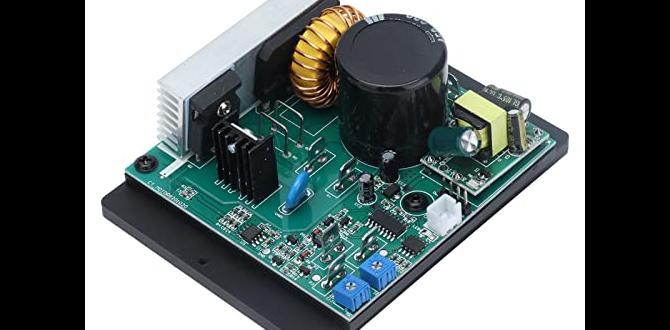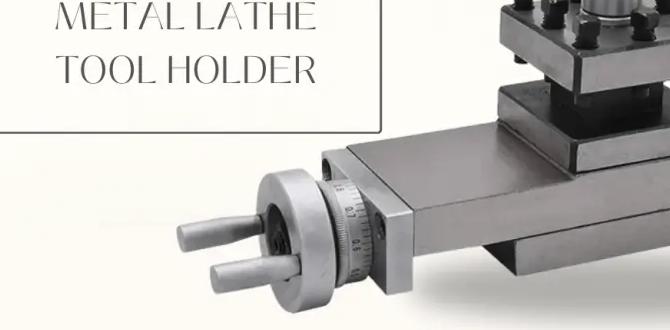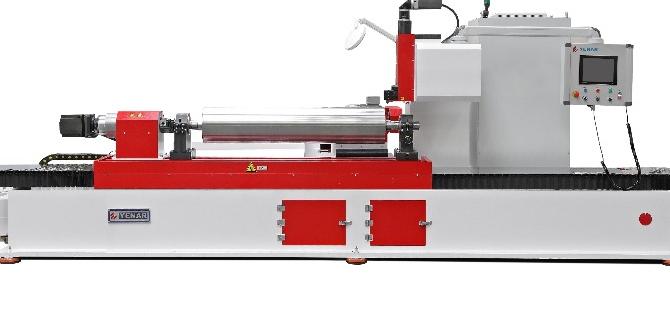Carbide end mills are crucial for accurately machining G10, and a 1/8 inch size, especially stub length with low runout, is often the best choice for hobbyists and beginners tackling this tough composite material.
Working with G10 can be a bit tricky, right? This fiberglass-reinforced epoxy laminate is tough stuff, and using the wrong cutting tool can lead to frustrating chips, rough edges, or even broken bits. If you’re looking to get clean cuts and precise shapes in G10, especially with your milling machine, you’ve probably come across the need for a specific type of cutting tool. Don’t worry, it’s not as complicated as it sounds! We’ll break down exactly why a 1/8 inch carbide end mill is your go-to tool for this job and how to use it safely and effectively. Get ready to make your G10 projects shine!
Why a 1/8 Inch Carbide End Mill is Your G10 Best Friend
So, what makes this particular end mill so special for G10? It boils down to a few key factors: the material of the end mill itself, its size, and its design features.
Carbide vs. HSS: Why Carbide Wins for G10
When choosing an end mill, you’ll often see two main materials: High-Speed Steel (HSS) and Carbide. For a notoriously abrasive material like G10, carbide is hands-down the superior choice.
Hardness and Heat Resistance: G10 is tough and generates a lot of friction when cut. Carbide is significantly harder and can withstand much higher temperatures than HSS. This means your end mill stays sharp for longer and is less likely to overheat and dull or even break when milling G10.
Edge Retention: Because carbide is so hard, it holds a sharp cutting edge much better than HSS. This sharpness is crucial for achieving the clean, smooth finishes you want on G10, preventing chipping and delamination.
Cutting Speed: Carbide allows you to cut G10 at faster speeds, reducing machining time and improving efficiency without compromising the tool’s integrity.
The Magic of 1/8 Inch for G10 Work
The 1/8 inch (0.125 inches) diameter might seem small, but for many G10 applications, it’s the sweet spot.
Detail and Precision: This size is perfect for cutting intricate details, small features, or making narrow slots. If you’re creating custom grips, enclosures, or model parts from G10, a 1/8 inch end mill gives you the control needed for fine work.
Reduced Cutting Force: Smaller diameter tools generally require less force to cut. This is beneficial when working with a material like G10, which can otherwise put significant stress on your milling machine’s spindle and the tool itself. Lower cutting forces mean less chance of tool breakage and cleaner cuts.
Common on Beginner Machines: Many desktop CNC machines and smaller manual mills are well-suited to handle the lighter loads imposed by a 1/8 inch end mill, making it accessible for hobbyists.
Understanding Shank Length: Why Stubby is Often Better
Shank length” refers to how much of the end mill sticks out from the collet or tool holder. For G10, a “stub length” end mill is often preferred.
Rigidity and Reduced Vibration: A shorter flute and shank length means more support for the cutting edge. This increased rigidity dramatically reduces vibration and chatter during cutting. Chatter is your enemy when milling G10, as it leads to rough surfaces and can break the tool.
Accuracy: Less flex in the tool means more predictable and accurate cuts, which is essential for fitting parts together or achieving precise dimensions.
When to Use Longer Shanks: While stub length is great for rigidity, you might need a longer shank if you need to reach deep into a workpiece or create long slots that are wider than the flute length. However, for most G10 surface milling and pocketing, stub length is king.
Low Runout: The Secret Ingredient for Clean Cuts
Runout is the amount of wobble or eccentricity in a rotating tool. Even a tiny bit of runout can make a big difference, especially with brittle materials like G10.
What is Runout? Imagine trying to cut a perfectly straight line with scissors that are slightly bent – the cut will be uneven. Runout is similar; it means the cutting edges aren’t spinning in a perfectly true circle.
Why Low Runout Matters for G10: Low runout (ideally less than 0.001 inches) ensures that each cutting edge engages the material consistently. This leads to:
Smoother surface finishes.
Less chipping and delamination of the G10.
Longer tool life.
Reduced stress on the milling machine and spindle.
Choosing Low Runout Tools: Look for end mills and collets that are marketed as having low runout or high precision. Investing in a good quality collet system for your milling machine will also significantly contribute to reducing runout.
Essential Specifications for Your 1/8 Inch Carbide End Mill for G10
When you’re shopping for this critical tool, here are the key specs to look for.
1/4 Inch Shank Stub Length End Mill for G10
This is a common and highly effective combination. A 1/4 inch shank is robust enough for a 1/8 inch cutting diameter and is a standard size for many hobbyist CNC and smaller manual milling machines. “Stub length” confirms that it’s designed for maximum rigidity.
Number of Flutes
Flutes are the spiral grooves on an end mill that carry away chips. For G10, you generally want a lower flute count.
2 Flutes: This is often the best choice for G10. The larger chip gullets (the space between flutes) can handle the fibrous nature of G10 better, preventing chips from recutting and causing overheating or tool damage. It also offers a good balance of cutting action.
4 Flutes: While good for finishing harder metals, 4-flute end mills can sometimes struggle with G10. They have smaller chip gullets, making them more prone to clogging and overheating with this material. If you choose a 4-flute, be prepared to run slower feed rates and use plenty of cutting fluid.
Coating
Tool coatings add a protective layer that enhances performance.
Uncoated: Perfectly fine for G10, especially when using a good feed rate and coolant.
TiN (Titanium Nitride): A common, affordable coating. It adds some hardness and lubricity, which can help with G10 but isn’t strictly necessary.
AlTiN (Aluminum Titanium Nitride): A more advanced coating offering superior heat resistance and hardness. This is excellent for G10 and can significantly extend tool life, especially if you tend to push your machines a bit harder.
Material of G10
While the end mill is key, understanding your G10 also helps. G10 comes in various resin systems and glass fiber densities, affecting its machinability. Generally, the principles for end mill selection remain the same, but a premium carbide end mill will tackle denser or tougher G10 variants more easily.
Getting Started: Preparing Your Workpiece and Machine
Before you even think about cutting, proper preparation is paramount for success and safety.
Securely Clamping Your G10
This is non-negotiable. G10 must be held down firmly to prevent any movement during milling.
Use a Vice: A sturdy milling vice is ideal. Ensure the G10 is clamped on its largest surface area to distribute the pressure evenly and avoid cracking. Use soft jaws or shims if you’re worried about marring the surface.
Fixturing: For more complex shapes or when needing to hold parts at an angle, custom fixtures or jigs are your best bet. These can be made from aluminum, MDF, or even another piece of G10.
Double-Sided Tape (Limited Use): For very light cuts or holding small parts for specific operations, strong double-sided workholding tape can sometimes be used, but it’s generally not recommended for significant milling where forces are high. Always ensure the tape is rated for the forces involved.
Setting Up Your Milling Machine
Whether you’re using a manual mill or a CNC, the setup is critical.
Collet/Holder Selection: Use a high-quality collet or tool holder. As mentioned, low runout is key. Ensure the collet is the correct size for your 1/4 inch shank end mill and is clean. A worn or poor-quality collet is a primary cause of runout.
Machine Rigidity: Ensure your milling machine is stable and well-maintained. Loose ways or a wobbly spindle will translate into poor cuts.
Zero Setting: Accurately set your X, Y, and Z zero points. For Z zero, it’s common to use a touch plate, a DTI (dial test indicator), or to carefully lower the end mill until it just kisses the surface of the G10.
The Milling Process: Step-by-Step for G10
Now for the exciting part! Here’s how to use your 1/8 inch carbide end mill to cut G10.
Step 1: Determine Your Cut Strategy
Before you start, have a plan. Are you pocketing a cavity, cutting a profile, or facing a surface? This will influence your feed rates and cutting depth.
Step 2: Set Your Cutting Parameters (Speeds and Feeds)
This is the most crucial part of achieving good results and preventing tool breakage. G10 is abrasive and can be brittle.
Spindle Speed (RPM): For a 1/8 inch carbide end mill in G10, a good starting point is usually between 10,000 and 20,000 RPM. Higher RPMs generally mean faster cutting but also generate more heat. You might need to experiment.
Feed Rate (IPM or mm/min): This is how fast the tool moves through the material. For G10, you want a relatively fast feed rate to allow the cutting edge to shear the material rather than rub against it, which causes heat and dulling. A common starting point might be 15-30 inches per minute (IPM) for a 1/8 inch tool, but this depends heavily on your machine’s rigidity, the specific G10, and your depth of cut.
Depth of Cut: For G10 and a 1/8 inch end mill, take shallow passes. A radial depth of cut (how far into the material the side of the end mill cuts) of roughly 0.020 to 0.040 inches is a good starting point. A depth of cut (how much Z axis the tool moves down per pass) of 0.050 to 0.100 inches is often manageable, but smaller is always safer. Taking too deep a cut will overload the tool and machine.
Tip: Always err on the side of caution with your initial cuts. You can always increase speed and depth slightly if your machine and tooling are handling it well.
Step 3: Consider a Cutting Fluid or Air Blast
While not strictly mandatory for every G10 job, using a coolant or an air blast can dramatically improve results.
Coolant: A flood coolant system or even a squirt bottle of cutting fluid can help reduce friction and heat, keeping the end mill sharp and the G10 from melting or deforming.
Air Blast: A directed stream of compressed air can help blow chips away from the cutting area, preventing recutting and debris buildup. This is especially useful in CNC setups.
Resources like the Engineering ToolBox offer general guidance on cutting speeds for various materials, though G10’s composite nature means practical testing is often required.
Step 4: Execute the Cut
With all parameters set and your workpiece secured, it’s time to mill.
Engage the Spindle: Start your spindle at the desired RPM.
Begin the Feed: Slowly engage the feed rate into the G10. Listen to the machine. A smooth, consistent cutting sound is good. If you hear chattering, grinding, or abrupt changes in sound, stop immediately.
Clear Chips: Ensure chips are being cleared from the flutes. If using a CNC, program this in. For manual milling, you might need to retract the tool periodically to allow chips to escape.
Workpiece Movement (CNC): If using CAM software, ensure your toolpaths are optimized for climbing or conventional milling based on what gives you the best results with G10 (climbing often yields smoother finishes but can increase tool wear or chatter risk if not set up perfectly).
Manual Milling: Use consistent, controlled movements. For pockets, a ‘zig-zag’ pattern for roughing and a ‘stepover’ for finishing can work well.
Step 5: Inspect and Repeat
Once a pass is complete, stop the machine and inspect your work.
Surface Finish: Is it smooth? Are there signs of chipping or burning?
Dimensions: Are you on target with your dimensions?
Tool Wear: Visually inspect the end mill for signs of excessive wear or damage.
If everything looks good, adjust your Z depth (if needed) and repeat the milling process for subsequent passes until you reach your final desired depth or shape.
Troubleshooting Common G10 Milling Issues
Even with the right tools, challenges can arise. Here’s how to tackle them.
Problem: Chipping or Delamination
Cause: Feed rate too slow, depth of cut too aggressive, blunt tool, excessive runout, or poor clamping.
Solution:
Increase feed rate slightly.
Decrease depth of cut.
Use a sharper tool or a new end mill.
Ensure your machine has low runout.
Securely clamp the G10 with more support.
Try a climb cut (if appropriate and your machine is rigid enough).
Problem: Overheating or Melting
Cause: Feed rate too slow, depth of cut too large, insufficient chip clearance, or lack of coolant/air blast.
Solution:
Increase feed rate.
Take lighter passes.
Ensure effective chip evacuation.
Use a coolant or air blast.
Reduce spindle speed if heat is extreme and you can’t improve chip clearance.
Problem: Tool Breakage
Cause: Taking too aggressive a cut, plunging into material too quickly (Z-axis), dull tool, poor clamping, or excessive runout.
Solution:
Drastically reduce depth and feed rates.
Always use appropriate Z-axis plunge rates.
Use a sharp, high-quality tool.
Ensure the workpiece is absolutely rigid.
Verify your machine’s runout is minimal.
Problem: Rough Surface Finish
Cause: Chatter (vibration), dull tool, incorrect feed/speed, or too much runout.
Solution:
Ensure your machine is rigid and all components are tight.
Use a sharp end mill.
Experiment with feed rates and depths of cut.
Minimize runout.
Consider a finishing pass with a shallow depth of cut and a slightly different feed rate.
For advanced machining of composites, understanding standards like those from CompositesWorld can offer deeper insights, though the fundamental principles for hobbyists remain consistent.
Alternative Tools and Techniques (and why they’re often less ideal for beginners)
While the 1/8 inch carbide end mill is king, you might encounter other options.
Uncoated End Mills: Cheaper, but they’ll wear out much faster in G10. Not recommended for serious work.
HSS End Mills: Generally not suitable for G10 due to poor heat and wear resistance. They will dull very quickly.
Larger Diameter End Mills: Can be used for G10, but they require more machine power and can struggle with fine details or intricate pockets. For general-purpose G10 work on smaller machines, 1/8 inch is usually optimal.
Drills: Can be used for making holes, but they cannot create slots or profiles. Special composite drills exist, but for general G10 machining, an end mill is far more versatile.
Safety First! Essential Precautions When Milling G10
Machining G10 involves dust and spinning tools, so safety is critical.
Eye Protection: Always wear safety glasses or a full face shield. G10 dust and small chips can be sharp and cause serious eye injury.
Respiratory Protection: G10 dust is a respiratory irritant. Always use a dust mask or respirator, especially when cleaning up. Consider a dust collection system for your machine.
Hearing Protection: Milling machines can be loud. Wear earplugs or earmuffs, particularly during extended operations.
Machine Guarding: Ensure all machine guards are in place and functioning. Never reach near a moving tool.
Sharp Tooling: Dull tools are dangerous. They require more force, increasing the risk of breakage and accidents.
* Fire Safety: While G10 itself isn’t highly flammable, resin dust can be. Keep your workspace clean and free of excessive dust buildup, especially near electronics







